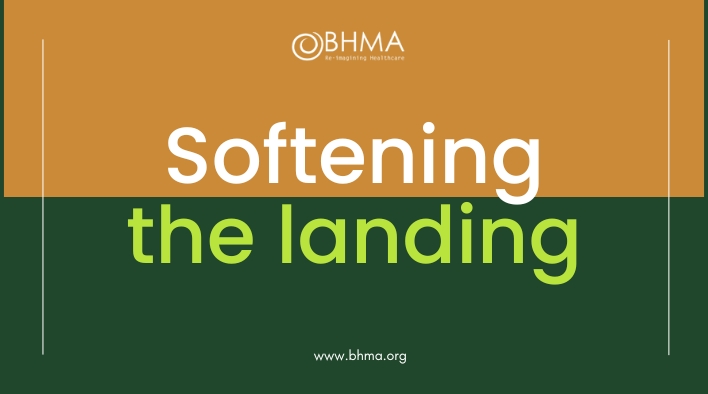Softening the landing
Hugh Grant Peterkin,Consultant liaison psychiatrist, East London Foundation Trust; honorary clinical senior Lecturer, Queen Mary University of London
Published in JHH18.1 – Flourishing in Medical Education
Ever since school days I have had a passion for the arts, especially theatre. Until the latter part of my training as a psychiatrist I kept this interest separate from my work but in recent years I have begun to explore how these two worlds connect – to support student wellbeing and explore thinking about patient care. I work as a consultant liaison psychiatrist in a busy London hospital. I am also in training to become a group therapist. I have interests in sustainability and the mental health of immigration detainees.
Some years ago I began offering short workshops for early years medical students as part of a student selected component on creative enquiry. I decided to use some drama warm-up games to start the sessions because, although such games can initially feel awkward, I hoped they would succeed in bringing the group together with renewed energy, connection and purpose. The response of medical students to these low-stakes, goalless exercises instead highlighted a harmful aspect of medical school culture and ultimately led me to change the focus of the games.
When I had experienced such games at my devised theatre school (a training I undertook during a two-year break from medicine) the games were played with a very strong focus. But when drama students forgot a word, dropped a ball or muddled a rhythm such ‘failures’ did not induce the levels of distress and frustration they did in medical students. The medical students’ irritation when they ‘failed’ was visceral; they almost seemed disgusted at themselves even when I explained the game was designed to be impossible.
This insight led me to shift the focus of the games so that the ‘failure’ was quite explicitly at their core. I encouraged the students to gently notice what happens in their body when they were given an ever larger number of tasks to complete all at once (for instance catch a ball, say a name, walk in a particular direction); to notice what happens in their body when they ‘fail’ and particularly to notice what it felt like to ‘fail’ in front of peers during a shared task. I encouraged them to repeat the game having reflected on the experience, to ‘fail’ again but this time to do so while showing kindness to themselves and each other.
It has been observed that shame lies right at the heart of medical education (Miles, 2020) and is intimately linked to medical students’ attitude to failure, which in turn impacts on their wellbeing (Hu, 2019; Bußenius, 2019). Failure is not something students or medical schools would ever encourage nor deliberately make part of a pedagogical process, as may sometimes be the case in tech start-ups and sports. Given that some degree of ‘failure’ is inevitable for all medical students it should not be the shame-filled, pervasive contaminating entity it currently appears to be. Creative processes, particularly ones that involve the body, can highlight this damaging aspect of medical school culture, and by bringing these feelings of shame into awareness, help soften their harsh edges in the hope that they will be less likely to harm our students.
A new anatomy
At the beginning of the workshop students were invited to draw a simple outline of a body and then colour in areas to signify emotional or physical states. Areas could be left blank where nothing was felt. Students were encouraged to see this as a process of enquiry rather than an artistic endeavour. In the workshop students engaged in a variety of tasks and games and were then asked to draw another outline and once again colour it in. The two images were placed side by side and comments were invited.
There was no right or wrong, only noticing. After initial reflections some questions were offered – how does your body feel different now compared with earlier? What do you think your body needs to undertake the challenge of studying medicine? How do you think your patients’ experience their bodies? Are your patients able to communicate their experience to you?
Such a creative process has a threefold aim: to support students to engage in self-care (the first step being to notice how they are feeling); for students to notice the impact of a creative practice on their own bodies and wellbeing; and lastly to see sensations and symptoms as interconnected and dynamic rather than discrete and static.
Thanks to Cara Verkerk for help in developing these tasks/games.
References
- Bußenius L & Harendza S (2019) The relationship between perfectionism and symptoms of depression in medical school applicants. BMC Med Educ, 19(1) 370.
- Hu KS, Chibnall JT & Slavin SJ (2019) Maladaptive perfectionism, impostorism, and cognitive distortions: threats to the mental health of pre-clinical medical students. Acad Psychiatry, 43(4) 381–385.
- Miles S (2020) Addressing shame: what role does shame play in the formation of a modern medical professional identity? BJPsych Bulletin, 44(1) 1–5. doi:10.1192/bjb.2019.49.







